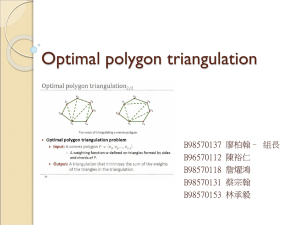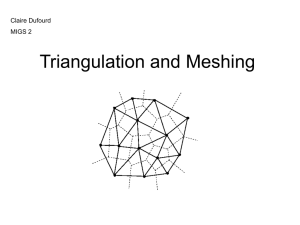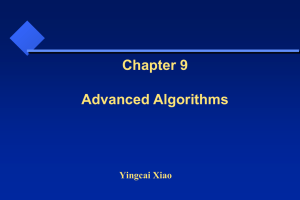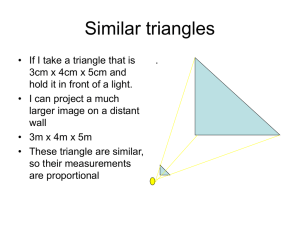Re-Triangulation Arithmetic in 3D Building Generalization
advertisement
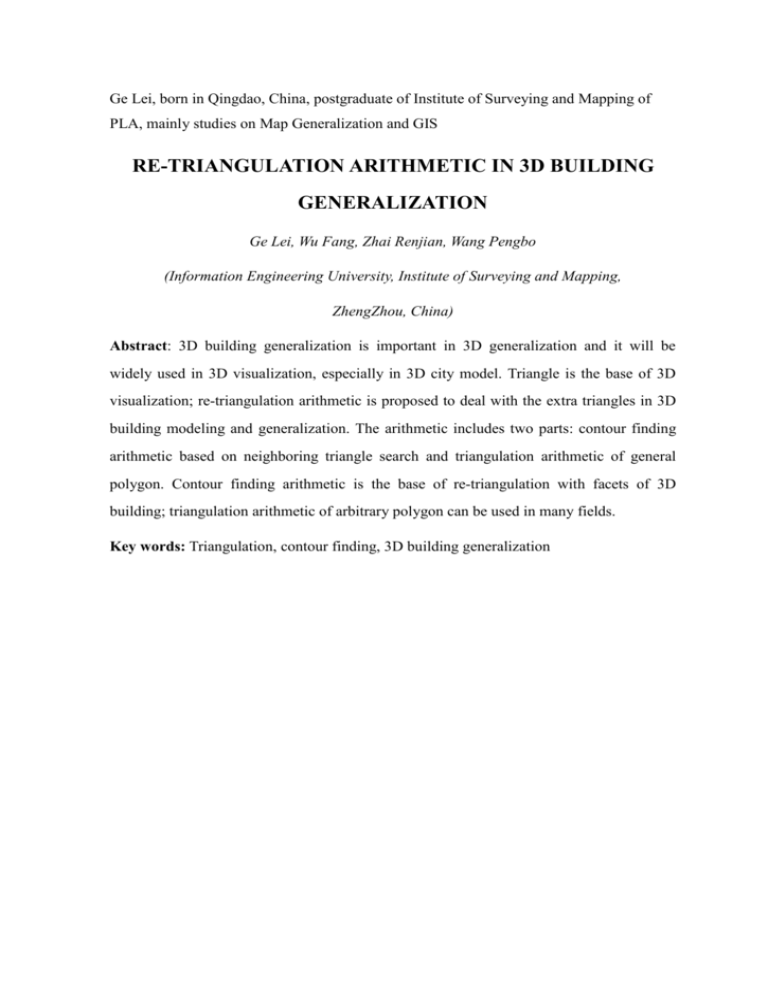
Ge Lei, born in Qingdao, China, postgraduate of Institute of Surveying and Mapping of PLA, mainly studies on Map Generalization and GIS RE-TRIANGULATION ARITHMETIC IN 3D BUILDING GENERALIZATION Ge Lei, Wu Fang, Zhai Renjian, Wang Pengbo (Information Engineering University, Institute of Surveying and Mapping, ZhengZhou, China) Abstract: 3D building generalization is important in 3D generalization and it will be widely used in 3D visualization, especially in 3D city model. Triangle is the base of 3D visualization; re-triangulation arithmetic is proposed to deal with the extra triangles in 3D building modeling and generalization. The arithmetic includes two parts: contour finding arithmetic based on neighboring triangle search and triangulation arithmetic of general polygon. Contour finding arithmetic is the base of re-triangulation with facets of 3D building; triangulation arithmetic of arbitrary polygon can be used in many fields. Key words: Triangulation, contour finding, 3D building generalization 1 Introduction Triangles are the basic cell to be rendered in 3D visualization. The number of triangle decides the speed of render and also has great influence on 3D data quantity. Re-triangulation of facet is an important way in the reduction of triangles. When using the most popular software in modeling 3D building, the quantity of surface triangles always exceed that is needed; in the simplification of parallel building, extra triangles come out because of facet moving. All these problems need to be solved by re-triangulation of facets. There have been many researches on triangulation arithmetic till now, most of which are concentrate on scattered points or known contour but not the unknown contour based on triangles. Therefore, a re-triangulation arithmetic mainly used in 3D building is proposed. The arithmetic could search the outline of facet consisting of triangles, so the contour is constructed automatically, which is used as the base of triangulation. The arithmetic is divided to two parts: a contour finding arithmetic based on neighboring triangle search and a triangulation arithmetic of arbitrary polygon. 2 A contour finding arithmetic based on neighboring triangle search 2.1 Basic definitions and rules Because of different building modeling methods and the change of triangles in simplification, triangles on facet is always more than the number required to describe building model, so that extra triangles come forth. Definition 1: un-coincident edges of two neighbor triangles are called isolated edge (P1P2, P1P3, P2P4 and P3P4 in Figure 1). Definition 2: un-coincident points of two neighbor triangles are called isolated point (P1 and P4 in Figure 1). Judge rules of the arithmetic: (1) Triangle with three neighbors is inside the facet and contains no border edge, so it’s the end of each search. (2) Two points of line segment must lay the neighbor odd and even position in array separately; otherwise the recorded points need to be regulated. Figure 1 Isolated edges and points of two neighbor triangles The ways to record line segments: Case 1: if the triangle has only one neighbor, add the four points of its two isolated edges to polygon border array. Case 2: if the triangle has two neighbors, add its isolated point to the polygon border array. Case 3: if the triangle has three neighbors, quit circulation and find the next qualified triangle. Get border TriFaceArray Vec3BorderArray Simplification Triangulation Figure 2 Relationship of the two important arrays in re-triangulation 2.2 Basic data structure Organization of data structure is the base of re-triangulation. The data structure Polygon used in arithmetic mainly includes two important arrays: one is Vec3BorderArray which memorize all the border line segments; the other is TriFaceArray that memorize all triangles on the facet. Figure 2 shows relationship of the two arrays in re-triangulation. 2.3 Steps of the arithmetic 1) Run all the triangles on each facet and check all its back triangles with the current one, if they are neighbors, add their indexes to each other’s array that record neighbor index. 2) Use the first triangle as the current one. 3) Check neighbor of the current triangle, if it has only one neighbor and unnoted, execute method 1; else use next triangle as the current one and continue with 3). If all triangles are checked, use first triangle as the first one and turn to 4). 4) Check if the current triangle has two neighbors, if it does and unnoted, execute method 2; else use next triangle as the current one and continue with step 4). If all triangles are checked, then all the border line segments are searched and turn to 5). 5) Order all border line segments of polygon. Use the first element of Vec3BorderArray as current line segment (each element is one line segment with two nodes). Search back elements to find the connected line segment and move it after the current one. Use next line segment as the current one and repeat the process above, when current element is the last one, turn to 6). 6) Combine all the collinear connected line segments of facet border (including the collinear first and end line segments) to get the polygon border. Then the contour finding arithmetic finished. Method 1 --- the way to get border points when the triangle has only one neighbor (1) Use the first element of its neighbor triangle array as the current triangle. (2) Check the number of current triangle’s neighbor. Take the unnoted neighbor as reference triangle and check the connection of the two triangles, then add points to Vec3BorderArray by the above way to record line segment and note the used triangles (except the one has three neighbors). The operation ends when the reference triangle has three neighbors. Method 2 --- the way to get border points when the triangle has only two neighbors Execute Method 1 to both of the triangle’s neighbors except when the number of its neighbor is 1. Compared with Method 1, the most important change is that the size of Vec3BorderArray -- VtIndex must be noted when changed and move the point at the position of VtIndex to the end to form line segment with the first point added in the next process after one neighbor processed. 3 Triangulation arithmetic of general polygon under constraints based on Delaunay triangulation network Triangulation of polygon is used widely in GIS, especially in 3D GIS and Virtual Reality. There are two kinds of triangulation, one is concentrated on scattered points and the other is based on polygon. The former triangulation is mainly 3D terrain modeling and triangulation of other ground features are usually based the latter. Triangulation arithmetic proposed here is based on Delaunay triangulation network and constraints are introduced to adjust the triangulation result. 3.1 Brief introduction to Delaunay triangulation based on triangulation network growth arithmetic The basic thought of triangulation network growth method is: firstly, find two points that have the shortest distance among all the points and line them as the first edge of Delaunay triangulation network; then find out the third point of the triangle according to the rules of getting Delaunay triangulation network, take turns to deal with all the newly born edges till the triangulation network is achieved. Difference between the triangulation methods are mainly on search of “the third point”. Detailed realization of different methods is not discussed here (see in reference [1]), and only the basic procedure of the triangulation network growth arithmetic is introduced. Basic procedure of triangulation network growth arithmetic (1) Begin with a random point, find out its nearest point and line them to be the baseline of Delaunay triangle. Find out the third point of Delaunay triangle according to the rules of Delaunay triangulation network (its basic character). (2) Line end points of baseline with the third point separately to form new baselines. (3) Repeat the steps above till all baselines are processed. 3.2 Constraints in triangulation To be part of the ultimate triangulation, a triangle must fulfill two constraints. Constraint 1: the triangle doesn’t cut border line of polygon; Constraint 2: an inner point of the triangle must be inside the polygon. If constraint 1 is not fulfilled, the triangle cut the polygon, as shown in Figure 3(a); if constraint 2 is not fulfilled, the triangle is outside of the polygon, as shown in Figure 3(b); proper triangulation is shown as Figure 3(c). Constraint 1 is the base of constraint 2. In the condition that the triangle doesn’t cut polygon, it can only be inside or outside of the polygon, so proper triangles could be obtained by constraint 2. (a) (b) (c) Figure 3 three types of triangles after Delaunay triangulation 3.3 Procedure of the arithmetic Step 1: change polygon border to scattered points by selecting the first point of each line segment. Step 2: triangulation of the scattered points using Delaunay triangulation network growth arithmetic to get array of triangles pNewFaces. Step 3: run all the triangles in pNewFaces and judge if one of its edges cuts polygon border. If it cuts, transform diagonal of the quadrangle constituted by the two triangles containing this edge to make two new triangles to replace the original two triangles. After running all the array and no more triangle that doesn’t cut polygon border, turn to step 4. Step 4: run all the triangles and judge the relation between middle point of each triangle’s random centerline and polygon. If the point is outside of polygon, remove it from pNewFaces. Step 5: compute normal of all triangles. If the normal is opposite to polygon normal, interconvert the first and third edges of the triangle and replace its normal with polygon normal. Step 6: compute normal of all vertices to fulfill the demand of visualization. The arithmetic ends. 3.4 analysis and instance of the arithmetic Compared with other widely used arithmetic, this one has its special advantages. Among the proposed triangulation arithmetic, triangulation based on determination of convex-concave vertices is most widely used. Compared this arithmetic with the one based on determination of convex-concave vertices, considering triangulation result, the former is based on Delaunay triangulation network and most of the ultimate triangles are optimal (except triangles adjusted by constraints); while the latter can’t optimize triangles in course and even the triangles are partial optimized, it’s inefficient and only optimized in a certain extent [3] . In fitting extension, the former can triangulate polygon of random shape (including polygon of multiple inclusion relation), while the latter mainly focuses on simple polygon and works badly in dealing with complex polygons. Efficiency is always the biggest disadvantage of triangulation based on Delaunay triangulation network. With the growth of point, complexity of Delaunay triangulation grow in geometric series, but to buildings having parallel structure, points on one facet is never too much (less than 100); additional, this arithmetic doesn’t have to consider the shape of polygon and even each line segment of polygon border can be present separately, which easier the process of triangulation. Generally, Delaunay triangulation arithmetic based on constraints has good efficiency, universality and excellent triangulation result. Figure 4(a) is grid model of a simple building that contains 112 triangles. After triangulation with this arithmetic, there are only 28 triangles left, as shown in figure 4(b). To this model, number of triangles reduces greatly and the result is ideal. 4 Conclusions The re-triangulation arithmetic proposed in the text solves the problem of extra triangles on facets of 3D building and works on triangulation with facets of other 3D entity. Contour finding arithmetic based on neighboring triangle search considers structure characteristic of building described by triangles and has great meanings in practice of re-triangulating 3D entities. Triangulation arithmetic of general polygon is easy to realize and works efficiently, break through limitation of simple polygon to be universal. This arithmetic could be used to get triangles with ideal shape. With re-triangulation of building model, texture doesn’t fit any more, so adjusting of texture is the key in the further research. Reference [1] Wang Jiayao. Theory of Spatial Information System [M].Science Press of China,2001. [2] Meng,L. and Forberg,A. 3D Building Generalization. Challenge in the Portral Geographic Information Issues of Generalization and Multi-Scale Representation, A.Ruas et al.ced, Elsvise,2005. [3] Yang Jie.Triangulation of Simple Polygon Based on Determination of convex-concave vertices [J].Mini-Micro System of China,2000,21(9):974-975. [4] Liu qiang, Li Deren.A Recursive Algorithm for Triangulation of Arbitrary Polygons Based on BSP Tree [J].Geomatics and Information Science of Wuhan University,2002,27(5):528-533.
